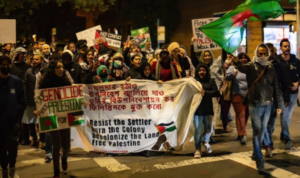Happy Durga Pooja

By Labiba Ali
Growing up in Old Dhaka, I experienced Durga Puja firsthand. My earliest memory was hearing the night air punctuated by the drumming of dhols, which played all night, all ten days of Durga Puja. The final night the dhols took on extra vigor as they accompanied Durga on her final journey to Buriganga River, and eventually upriver to her home in the Himalayas.
Shankhari Bazar is the hotspot for Durga Puja in Old Dhaka. Its narrow lane is lined with temples. During the Puja traffic is closed off and devotees weave through the temples offering prayers to Ma Durga. Each temple has its own Durga pandal and there is stiff competition on whose Durga statue is the best. Making the Durga statues is an art and an act of devotion. What I love most about Durga statues are her bold ferocious eyes and her wild curly hair. In this she epitomizes the duality of Bengali womanhood – fierce yet compassionate.
It is hard to pinpoint the origin of Durga. She probably started out as a pre-Aryan Goddess who was later incorporated into the Hindu pantheon. In Bengal, Goddesses are more celebrated than Gods, such as Chandi, Manasa, Kali. This could be down to our pre-Aryan roots that was matrilineal rather than patriarchal. When the Aryans arrived around 2000 BCE, they introduced a more patriarchal society to the subcontinent. But Bengal is outside Aryavarta (Aryan heartland in the Gangetic Plain of North India) and so Bengal was never as Aryanized. Instead Bengali culture is a glorious kichuri of pre-Aryan, Buddhist, Hindu, and Muslim influences.
Durga Puja is now a major Hindu festival that celebrates the victory of the Goddess Durga over the demon Mahisasur. The God Brahma had blessed Mahisasur that no male could kill him. Hence the task was given to Durga. The festival is immensely popular in the eastern part of the subcontinent, particularly in Bengal (today’s Bangladesh and West Bengal). It is held over 10 days in the Fall, during the first fortnight of the month Aswin or Kartik.
For us Bengalis, Durga has always been extra special. The great Bengali writer Bankim glorified her in his epic poem ‘Vande Mataram’ (Salute to Mother). In many ways Bengal is Durga and Durga is Bengal.
Photos from Victoria and Albert Museum, London, UK
Read More
The Legacy of Boi Mela
Every year in February, the month-long national book fair welcomes...
Read MoreMillennial Amma: How to Explain a Global Crisis As a Parent
Rumki Chowdhury shares tips for how to talk to children...
Read MoreBegum Rokeya’s Millennials
A tribute to a pioneering Bengali feminist writer, educator and...
Read More



